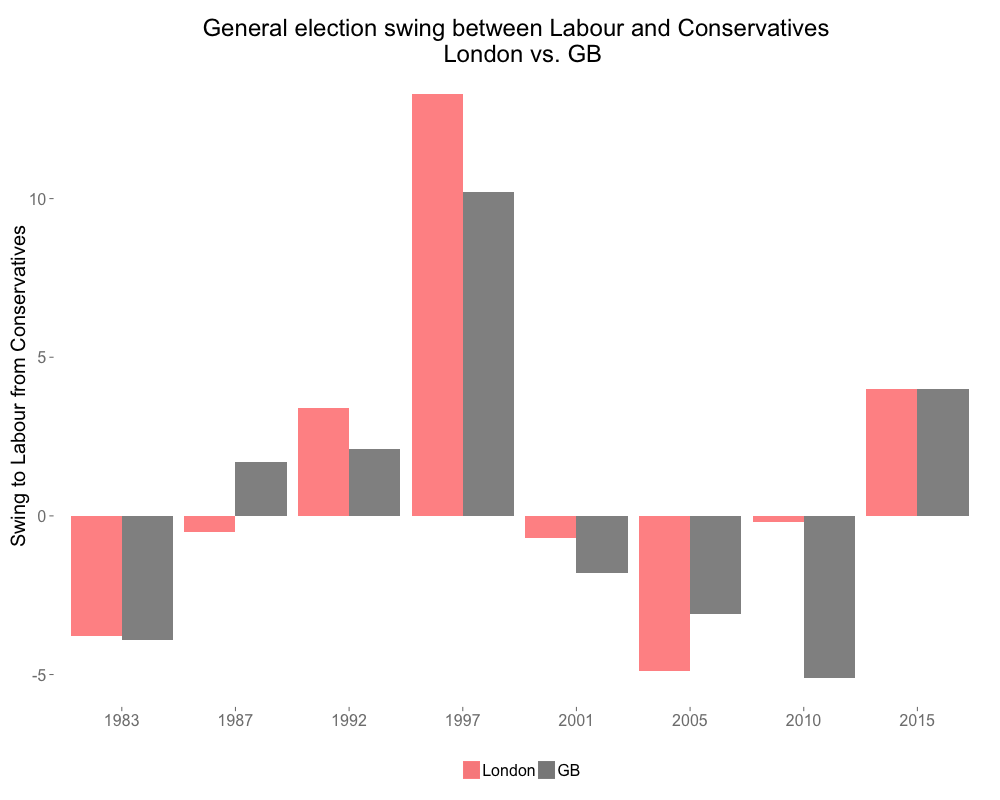 Is Labour losing its capacity to take vote share from the Conservatives in London? In this post, Tony Travers compares the historic performance of the Labour party in the UK as a whole to its performance inside the capital.
Is Labour losing its capacity to take vote share from the Conservatives in London? In this post, Tony Travers compares the historic performance of the Labour party in the UK as a whole to its performance inside the capital.
For a number of years now, commentators have observed that London is, or is becoming, a ‘Labour city’. The party’s performance at the 2010 general election and in the borough elections on the same day certainly suggested the Conservatives were in gradual retreat in the capital.
For many years, general election vote share in London for the Conservatives and Labour had been similar to their GB shares. Despite its many unique characteristics, the capital’s voters produced vote proportions for the Tories, Labour and Liberal Democrats which mirrored their results for the country as a whole. But from 1997 onwards, Labour had been gradually pulling ahead. Vote share in 1997, 2001 and 2010 was significantly above the GB figure. In 2005, this advantage reduced somewhat as the capital’s young and diverse voters reacted to the Iraq war.
A recent Evening Standard/YouGov poll showed Labour on 42 per cent in London and the Conservatives on 32 per cent. This 10 per cent gap is significantly wider than those shown for GB as a whole and might, at first sight, suggest that Labour was continuing to stretch its lead in the capital. But as UK Polling Report’s Anthony Wells observed in the Standard “However, unlike in 2010, when it [Labour] did better in the capital than the rest of the country, it shows no signs of out-performing in London”.
This observation begs the question of whether Labour’s message is reducing the party’s propensity to attract a still larger share of London’s progressive and pro-Europe voters. The graph below shows last week’s opinion poll findings compared with Labour’s performance in each general election since 1983.
The graph shows that when voters are swinging towards Labour nationally, they tend to do so to a greater extent in London. Conversely, when voters swing toward the Conservatives nationally, the swing is less pronounced in London. Thus, in 2010, while there was an anti-Labour swing of just over 5 per cent in Britain as a whole, the equivalent figure for London was just 0.2 per cent. In every election since 1983 except two Labour has, in terms of ‘swing’ between the two major parties, performed better in London than in the country as a whole.
1987 was in the middle of the ‘Thatcher vs the Left’ period of urban politics which for a time damaged Labour. 2005 was an election where there was evidence that, in a number of constituencies, voters punished Labour for the Iraq war. But in 1992, 1997, 2001 and 2010 Labour out-performed their national vote share in London, so that by 2010 London really was becoming a ‘Labour city’. The last set of bars in the graph shows the recent Evening Standard/YouGov poll. The Conservative to Labour swing in London since 2010 is four per cent, the same as in GB. A YouGov poll in December showed only a three per cent swing in London compared to 2010, below the national equivalent figure at the time. So, thus far, there appears to be no further relative swing from the Conservatives to Labour since 2010. Of course, there is still plenty of time for things to change between now and the election, and it is possible that by May 7 Labour will enjoy a larger swing from the Conservatives in London than those suggested by the December and January polls.
A similar pattern can be found in the second graph which shows the performance in London borough elections compared to the National Equivalent Vote Share (NEVS) in elections since 1986 (1982 cannot be included because there are no NEVS figures for 1978). In all but 1990 and 2002, Labour out-performs in London.
But it is also possible that other factors will come into play this time around. For example, the pre-Christmas BES conference included research suggesting some minority voters may be becoming less inclined to vote Labour. Perceptions of Labour’s tax policies, particularly in relation to the ‘mansion tax’, may be an issue. Could there be a ‘Boris effect’ which was not present in 2010? Or have the two big parties simply seen their changing vote shares level-off?
The coming election is likely to see voters switching from major parties to smaller ones in ways that affect the relative vote shares of the Conservatives, Labour and the Liberal Democrats. Within London (or any other part of the country) it is these effects which are increasingly likely to drive constituency results. But there may also be region-wide effects. The wonderful thing about elections and the research done about them is that they test (at least some) of these theories.
Note: Tony spoke about this piece, and other election issues, on this week’s Polling Matters podcast. An associated piece, and link to the podcast, can be found here. This article was originally published on our sister site, the LSE’s General Election blog.
 Tony Travers is Director of LSE London, a research centre at the London School of Economics and Professor in the LSE’s Government Department.
Tony Travers is Director of LSE London, a research centre at the London School of Economics and Professor in the LSE’s Government Department.










A recent Evening Standard/YouGov poll showed Labour on 42 per cent in London and the Conservatives on 32 per cent.
But as UK Polling Report’s Anthony Wells observed in the Standard “However, unlike in 2010, it (Labour) shows no signs of out-performing in London”.
Has Anthony Wells actually looked at the poll? Of course Labour is outperforming the Tories if Labour has a comfortable 10 point lead. And Labour is outperforming in London which is shown by that large lead while the lead elsewhere is about 2%. Why is this pollster ignoring the figures in front of him?